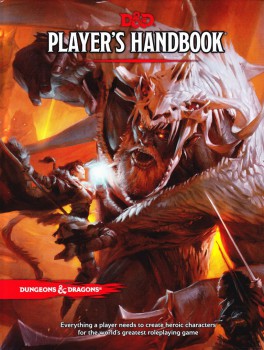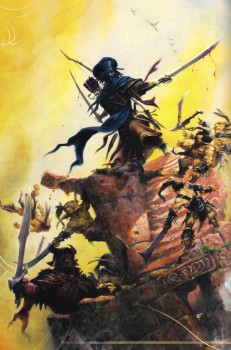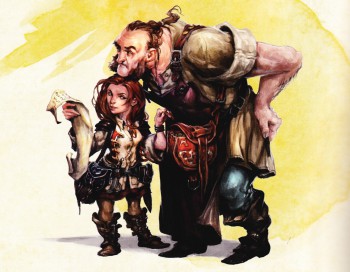Art of the Genre: When an Old School Mind Learns How to Play D&D 5th Edition
 I remember when I first played Basic D&D, then the first time I played AD&D, then 2nd Edition AD&D, and finally 3rd Edition D&D right around the turn of the millennia. By the time 4th Edition came around, I no longer had a regular gaming group and didn’t care to reinvest my time, money, and shelf space in yet another iteration of Dungeons & Dragons.
I remember when I first played Basic D&D, then the first time I played AD&D, then 2nd Edition AD&D, and finally 3rd Edition D&D right around the turn of the millennia. By the time 4th Edition came around, I no longer had a regular gaming group and didn’t care to reinvest my time, money, and shelf space in yet another iteration of Dungeons & Dragons.
Still, that didn’t stop me from continuing on with the hobby, from 3.5 to Pathfinder, and finally all the way back to my renewed love of the original Advanced Dungeons & Dragons some time around 2010. When I heard that Wizards of the Coast would be rolling out another edition of D&D in 2014, this one initially referred to as ‘Next’ and now 5th Edition, I wasn’t much into the idea of vesting time in it, but after having skipped over 4th Edition, I did feel a need to at least see what the new concepts were about.
Thankfully, I’ve had a chance to first preview the content of the 5th Edition Starter Set box and finally the initial release of both the 5th Edition Player’s Handbook and the first campaign adventure, Hoard of the Dragon Queen.
In today’s Art of the Genre, I’ll be looking over the Player’s Handbook as my well-aged brain tries to grasp what WotC and 175,000 test gamers thought D&D should look like circa 2014.
First things first, the book is just over 300 pages, bound as a lush hardcover with a very nice tactile page break on the back cover (you’d have to feel it to understand what I’m talking about) and is done in full color with a glossy page that has the aspects of old parchment.
The rules are broken up into three distinct ‘Parts’. Part 1 details everything you need for character creation, including background, equipment, and customization options (more on this later); while Part 2 hits ability scores, adventuring, and combat; and finally Part 3 finishes things off with spellcasting and magic.
At first glance, I had to wonder why a game that once consisted of a thirty-page manual now needed ten times the pages to explain, but nonetheless I dug in anyway in hopes I wouldn’t get bogged down by the content.
 Thankfully, the writing is smooth and easy to understand, and although the process of character creation seems ‘heavy’, the concepts were sound, reflected the same ‘old D&D’ feel, and had me intrigued on some of the new wrinkles, namely ‘background’ and a mechanic known as ‘advantage and disadvantage’. Now having never played 4E, I’m unsure if these are exactly new concepts, but at least they were new to me so I looked forward to trying to understand them.
Thankfully, the writing is smooth and easy to understand, and although the process of character creation seems ‘heavy’, the concepts were sound, reflected the same ‘old D&D’ feel, and had me intrigued on some of the new wrinkles, namely ‘background’ and a mechanic known as ‘advantage and disadvantage’. Now having never played 4E, I’m unsure if these are exactly new concepts, but at least they were new to me so I looked forward to trying to understand them.
Characters in 5th Edition are basically the usual suspects, same ability score generation, same classes, same hit dice, and same races (although Tiefling was in there which might also be a 4E holdover, as is Dragonborn). Another reflective concept of 3rd Edition was a standardized experience point system for ALL classes and a neat new mechanic called ‘Proficiency Bonus’ which basically adds to most actions the character takes and goes up in tiers with as the character advances from 1st to 20th level.
Speaking of experience points, I’m anxious to see just how experience is divvied out in 5th Edition as 2nd level requires 300 experience points and 20th level 355,000, which doesn’t exactly equate to the games I know, but does seem to indicate a much more rapid level rise, assuming experience is easy flowing.
Classes are standard, although one new one, the Warlock, stood out to me among the fighters, wizards, and rogues, but just so you know, all classes and descriptions now take up nearly 100 pages of the book, so there is A LOT more detail and manipulation by players allowed outside the realm of creative role-playing.
I’m going to take a couple of minutes to detail Part 1; Chapter 4: Personality and Background because I think it is a formulaic attempt to get players deeper into their character BEFORE they start instead of after the character survives ‘the funnel’ and begins to grow naturally, as I’m used to.
Hold on a second, my phone is ringing and it is my old gaming buddy Murph, so let me get it…
40 minutes later…
Okay, I’m back, and what do you know, Murph asked if we’d ever play 5th Edition. You know, I’d not really considered it until he asked. We’d gone from Pathfinder back to 1E AD&D a couple of years ago and I thought I wouldn’t go to another system again, but after talking about Pathfinder with him and our final campaigns in the seemingly bloated and over-evolved system, I’m now rethinking things as I look over the remainder of this book, so keep that in mind.
 So back on task, this chapter [4] talks about receiving two personality traits, but you make them up, no charts available, and then there is a bit on Ideals, Bonds, and Flaws before getting a taste of something called ‘Inspiration’ and finally the big one, ‘Backgrounds’. This is described in the pages as ‘background reveals where you came from, how you became an adventurer, and your place in the world’. The mechanics here help add some extra things like proficiencies, languages, and equipment in a kind of starting ‘package’ that gives the character just another interesting leg up upon start.
So back on task, this chapter [4] talks about receiving two personality traits, but you make them up, no charts available, and then there is a bit on Ideals, Bonds, and Flaws before getting a taste of something called ‘Inspiration’ and finally the big one, ‘Backgrounds’. This is described in the pages as ‘background reveals where you came from, how you became an adventurer, and your place in the world’. The mechanics here help add some extra things like proficiencies, languages, and equipment in a kind of starting ‘package’ that gives the character just another interesting leg up upon start.
I do this myself in my home brew, but my world has 30+ years of real gaming history, so it was nice to see the designers incorporating it for new players right off the bat. Example starting backgrounds include Noble, Sailor [with pirate variant], Sage, Outlander, etc.
When I got to equipment, and AC goes up in case you were wondering, there is a good bit on lifestyle and expenses that would normally have been found in a DMG, but here it is made available to players so they can drive their DM nuts with all the cool stuff they want in life.
Now knowing 3rd Edition and its iterations, Feats were always something that seemed both a blessing and a curse. In 5th Edition, there is an optional rule where instead of a character’s ability scores moving up at certain levels [ala 3rd Edition], a character can instead choose to add a Feat. Although the Feats are not as extensive as 3E [or heaven forbid Pathfinder] it does allow for some added customization such as dual wielder, actor, crossbow expert, etc.
We finally move into the later stages of Part 2, Chapter 7: Using Ability Scores. This chapter shows the standard 3E concept ability score use while also incorporating Advantage and Disadvantage as well as Proficiency Bonus. Now Advantage and Disadvantage are interesting concepts where the character is either better or worse at making a roll on a D20. If you have Advantage you roll two D20s and take the higher result, but if you have Disadvantage you roll two D20s and keep the lower. I’m not sure how this works in a real game, but I’m sure the playtest found it to be a good solution to things. Whatever the case, I’m intrigued by it.
Now since I was thinking about old Murph and his question, I decided I wanted to take a stronger look at the mechanics side of things, namely magic, equipment, and combat. In doing so, I noted that magic had a very interesting new wrinkle for ‘spell slots’ which kind of worked like an old ‘mana’ system I’d incorporated in my D&D world around 1998. Also, the system took into account that a caster could use a more powerful spell slot on a less powerful spell, thus kind of turbo charging it, and I like that concept. So magic, while roughly the same as 1E-3E does have thoughts that might improve a thing or two.
Equipment also intrigued me in that armor no longer ‘adds’ to your AC but instead has a base value [like 1E] although it goes ‘up’ like 3E. There is also a cool new subcategory rating for weapons that give purpose to things like finesse or two-handed wielding, in that using a rapier with proficiency allows you to use Dex modifiers without need of Feats. Also, there is a different damage code for wielding weapons [including longswords] two-handed, which again, is a nice touch.
Combat is much the same, although the ‘critical threat range’ is gone from weapons and there is no ‘confirming critical’ stuff, just roll a natural 20 and you get an auto hit and a critical, which is how we did things in old school.
 These kind of refined touches, and addition by subtraction, showed that the designers had done their due diligence when it came to creating 5th Edition and that I’d like to say it is, in my opinion, a fine upgrade to what Pathfinder became after D&D 3.5. This game is a more thoughtful, streamlined, and purposeful creation that has intrigued this old gamer enough that I WILL play a campaign with it and see what I think at the table. So congrats to Mike Mearls and Jeremy Crawford as well as all the other designers for creating this version.
These kind of refined touches, and addition by subtraction, showed that the designers had done their due diligence when it came to creating 5th Edition and that I’d like to say it is, in my opinion, a fine upgrade to what Pathfinder became after D&D 3.5. This game is a more thoughtful, streamlined, and purposeful creation that has intrigued this old gamer enough that I WILL play a campaign with it and see what I think at the table. So congrats to Mike Mearls and Jeremy Crawford as well as all the other designers for creating this version.
Also, since this is Art of the Genre, I’d like to share one last thought on art. I have to say, the cover of the ‘Starter Set’ didn’t thrill me, and to be honest it looked a bit like someone had a photoshop assignment and needed to finish it before deadline so they left all detail smeared and ‘foggy’ [which I think is a lazy quality that is too often replicated in digital art these days].
This Players Handbook, however, does a sound job of providing an evocative cover of old King Snurre Ironbelly [who I’ve killed 4 times over the past 30 years]. Artist Tyler Jacobson was a great choice for this assignment, and the cover it great fun.
Inside, a bevy of artists [62 of them if my count is correct] do a very nice job bringing the game to life. Seriously, pretty much EVERYONE who does quality work in the field today was in on this, and my only two real knocks are that various Halfling images aren’t my ‘thing’ [huge heads and tiny legs] and that the designers didn’t give page credits to artists that we’d grown used to in 3rd Edition. As an AD myself, this makes it must more difficult to identify art I’d like to contract myself, and with 62 artists, hit and miss on ‘eye testing’ these images can be overly problematic.
So, I hope my review has helped in some fashion, and I also hope that like me and Murph, you’ll give 5th Edition a try. It doesn’t seem the ‘evil and unneeded money grab of doom’ that most older folks felt 4th Edition was, and it isn’t WoW with dice. Instead it seems a more natural evolution from 1E forward, and for that, I once again tip my hat to Wizards of the Coast.
If you like what you read in Art of the Genre, you can listen to me talk about publishing, and my current venture with great artists of the fantasy field, or even come say hello on Facebook here. And my current RPG Art Blog can be found here.
Looking forward to playing this during The Week next year.
I think this will be one of the first systems in a while where you and Mark didn’t go, “Here’s the book, Murph. You figure out the magic system.” =)
True enough Murph, but that doesn’t mean you won’t still take the book and work with all your might to try to maximize/break the magic system anyway 🙂
I picked up the starter set when it came out but i haven’t had anytime to read it yet.
its been hard enough just to get my friends together for one night.
we’re really hoping that the combat is faster and that its an overall simpler game. Your review seems to indicate that.
If you have friends who play, Glenn, I’d suggest NOT moving 2000 miles away from them if given the chance. Just a suggestion, as it certainly bit my playing time in the ass 🙂
[…] Art of the Genre: When an Old School Mind Learns How to Play D&D 5th Edition […]